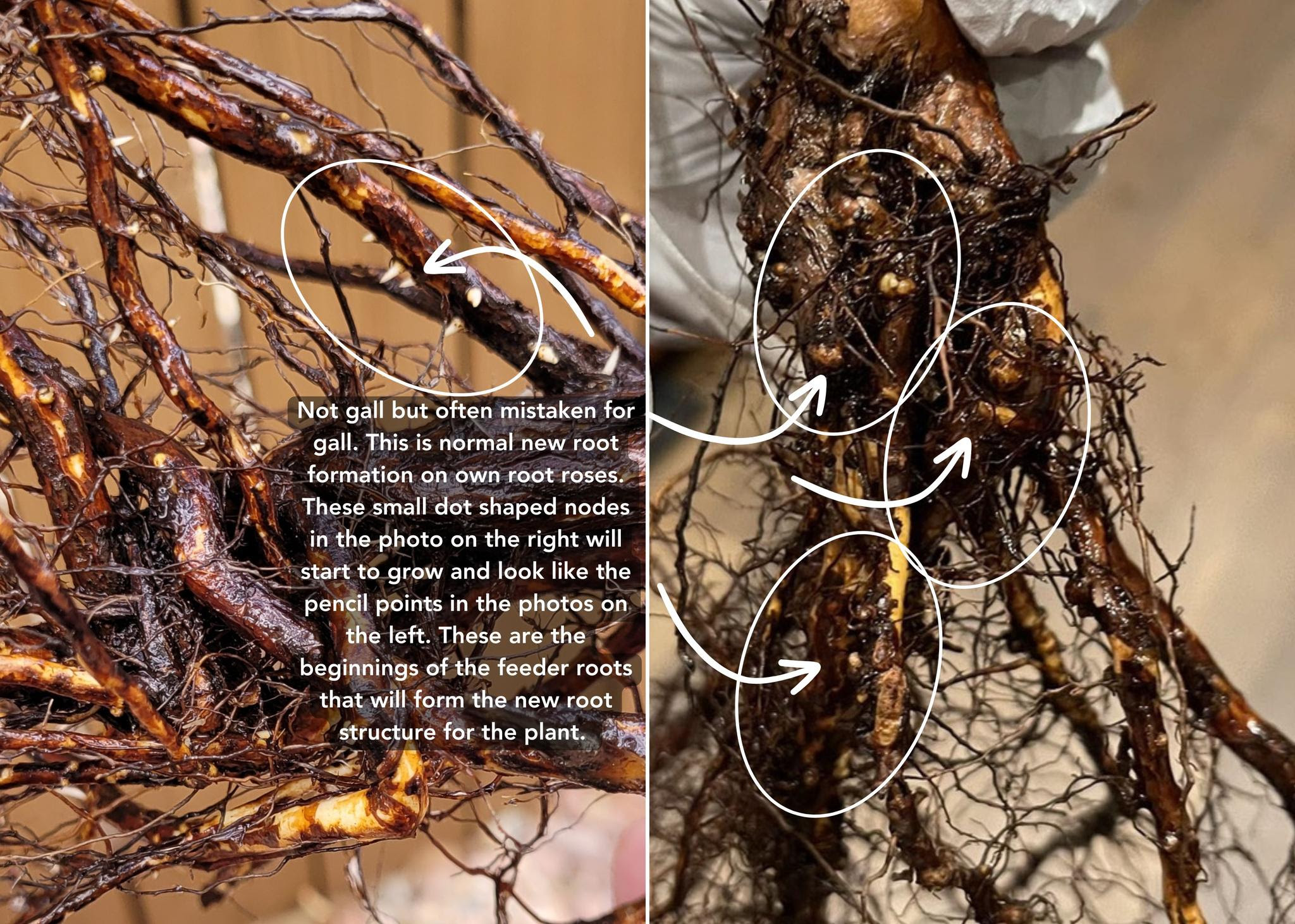What is gall in roses, and can bare root roses be infected? Should rose growers be concerned, and what steps should they take if they find it?Updated 9 months ago
What is gall in roses?
Gall refers to abnormal, tumor-like growths that can form on a rose's roots, stems, or crown. The most common type found on roses is crown gall, caused by a soil-borne bacterium called Agrobacterium tumefaciens. This bacterium is extremely common (like as common as herpes/cold sores or chicken pox/shingles in humans) and likely is already in the native soil somewhere in your yard already. It infects the plant through wounds, stimulating the production of irregular tissue growth. The galls are usually rough, knobby, and woody in texture. They can vary in size, starting small but potentially growing quite large. While a few galls may not seem alarming initially, severe infections can restrict nutrient & water uptake and weaken the plant, making it more susceptible to stress and other diseases.
Are your bare root roses at risk of infection?
Agrobacterium tumefaciens can affect roses, especially if they are handled roughly, leaving wounds exposed. Grafted roses are particularly vulnerable, as the bacteria can enter through the bud union. Even at reputable nurseries, where stock is meticulously inspected, it's possible for infected plants to occasionally slip through since it's such a common bacteria. At Menagerie, we employ (as do our partner growers) a comprehensive inspection and treatment protocol from the moment our roses are planted. Every propagation cutting is treated with Galltroll-A to prevent infections from the start. During multiple post-harvest stages—grading, bunching, and order fulfillment—plants are meticulously hand-inspected, ensuring at least five points of human oversight. We conduct soil solarization annually to maintain bacteria-free soil and rotate our planting locations, ensuring roses follow a three-year planting cycle. While it's not impossible to receive a bare root rose from us with a gall infection, our rigorous mitigation process makes it highly unlikely. Most reputable nurseries follow protocols similar to ours to ensure the health and quality of their bare root roses.
How to accurately identify gall.
Over the years, I've received many messages and photos from people confusing galls with normal root growth, particularly in own-root roses. It's crucial for rose gardeners to understand a rose plant's normal anatomy. This knowledge helps accurately distinguish between galls and normal plant growth.
 Gall in the early stages at the graft (bud union) on a bare root rose. They have a distinct tumor-like appearance.
Gall in the early stages at the graft (bud union) on a bare root rose. They have a distinct tumor-like appearance.
 Not gall but often mistaken for gall. This is normal new root formation on own root roses. These small dot shaped nodes in the photo on the right will start to grow and look like the pencil points in the photos on the left. These are the beginnings of the feeder roots that will form the new root structure for the plant.
Not gall but often mistaken for gall. This is normal new root formation on own root roses. These small dot shaped nodes in the photo on the right will start to grow and look like the pencil points in the photos on the left. These are the beginnings of the feeder roots that will form the new root structure for the plant.
Should you worry about gall?
While crown gall sounds like a menace, its impact depends on the severity of the infection, the variety and the conditions in your garden. Most roses thrive just fine and you likely won't ever know they are infected with gall unless you dig them up and inspect the roots. Severe infections however can significantly weaken a rose, especially in poor soil or high-stress environments. The bacterium can persist in soil for years, potentially infecting future plantings. For an avid rose grower, it's smart to stay vigilant but not paranoid. Routine inspection and proper sanitation can mitigate most risks. No need to run around like the sky is falling!
What should you do when you receive a bare root rose?
Inspect a rose when you receive it and look for unusual growths or swelling around the bud union (on a grafted rose) or roots. Healthy roots should appear uniform without any lumpy tumors or woody galls. (They do look like tumors and trust me when I say that it will be easy to spot if you have one on a plant.) Handle roses carefully to ensure you're not wounding the rose further during planting, as this creates an entry point for bacteria. Treat the roots/plant with a bactericide solution (such as copper-based fungicides, Gallex or Galltroll-A ) before planting, especially if you're worried about contaminated soil in your own garden. Consider planting in a new, uninfected location if you've had issues with crown gall before. If you think you've found gall on a rose you received, don't plant it, and contact us to verify if the growth you suspect to be gall actually is.